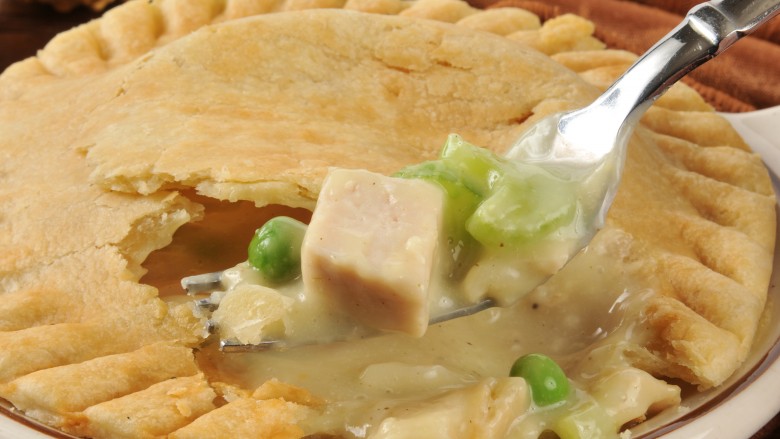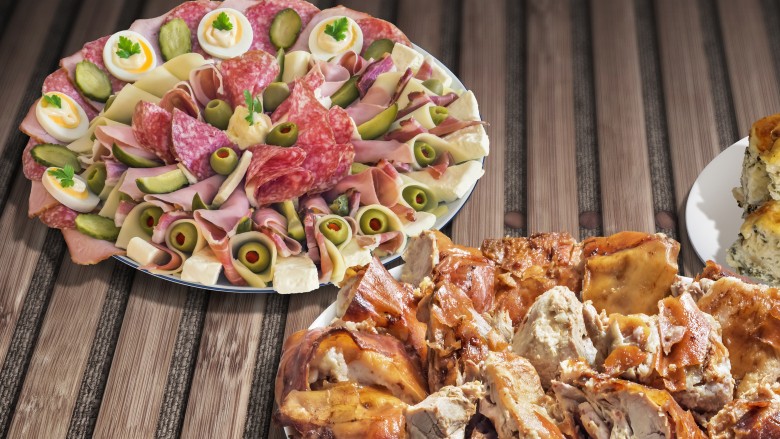Bizarre Stories Connected To Popular Foods
Our favorite foods are a source of comfort, joy and good eating. But beneath the delicious exterior, many foods have bizarre tales connected to them: stories of murder, global conquest and child slavery that will ruin your appetite.
Colin Adlard murdered his wife over bad mashed potatoes
Marriages are difficult for most people, but few get to the point of violence. Even fewer end in murder. Out of those terribly tragic cases where wedding bells lead to blood and pain, few are as baffling as Wendy Adlard's murder.
For years, the Adlards had argued. Things got worse when both Wendy and Colin lost their jobs. Colin worked as a geophysicist, but between 2000 and 2005 suffered a horrible cocktail of a brain haemorrhage, stroke, and heart attack. Needless to say, he couldn't work anymore. Resentment entered the marriage. Both husband and wife got frustrated with their financial situation, letting their marriage devolve into bitter arguing.
It all came to a head during an extreme argument over the stupidest thing: the quality of Wendy's mashed potatoes. They were so bad to Colin, it sent him into a murderous rampage. Years of resentment got unleashed — when Wendy went to bed, Colin fed the dogs, grabbed a hammer, and smashed in his wife's head. The murderous husband described a red mist (and probably the image of terrible mashed potatoes) descending over him during the attack.
Wendy died on the way to the hospital and Colin got life in prison. With so much time to think about those potatoes, hopefully Colin regrets his decision to put the "banger" into bangers and mash.
Paul Dennis Reid's fast food rampage
Fast food is killing us, but for seven Tennessee residents in 1997, taking a trip to a fast food place ended their lives a lot faster than greasy hamburgers — they were victims of Paul Dennis Reid's bloodlust. Reid killed his victims exclusively at fast food locations, earning him the descriptive, but not very creative, nickname of "the Fast Food Killer."
The exact reason for Reid's murderous rampage is unknown, but it was probably sparked by his failed music career. Reid first arrived in Nashville to try to make it big in the music scene, but never caught a break. Instead of making a more normal career change, Reid decided that turning into a notorious mass murderer was the only way to cope.
Reid's first victims were at a Captain D's seafood restaurant. Early in the morning, he entered the restaurant and shot two early-morning employees, execution style. One month later, he attacked a McDonald's restaurant, killing three and stabbing another victim 17 times. Even though the police turned the state upside-down looking for him, Reid managed to commit one more crime, kidnapping two girls from a Baskin-Robbins and slitting their throats in a nearby cave.
For some reason, Reid decided afterwards that he needed a full-time job in food service. Getting into some classier digs, Reid started working at a steakhouse. His blood lust didn't subside, and he attacked the manager. When the cops arrested him, they realized that they had captured the "Fast Food Killer."
After trial, Reid got seven death sentences, though he died in 2013 of natural causes. Tennessee won't soon forget this infamous killer that made McDonald's dangerous for more than just a high calorie count.
Graham crackers were designed to cure masturbation
Most of us don't think too much about graham crackers. They're good in s'mores and in pie crusts, but they're not something that's going to change the world. However, if after eating a delicious s'more, you suddenly find yourself wanting to stop masturbating, don't be alarmed. The crackers are serving their intended purpose.
Back in the 19th century, a ton of people thought that masturbation was really bad for you, causing all sorts of physical and emotional issues. Alarmed by supposed destruction caused by rubbing one out, Presbyterian minister Sylvester Graham tried to create a food to stop sexual urges. The original graham cracker was super bland and more like bread, very different from its modern namesake. Theoretically, the blandness stopped any passionate urges in his Presbyterian followers.
Graham was a highly regimented fellow obsessed with removing the sexual urges in his followers. He advocated sleeping on a hard mattress without pillows, eating no red meat, and having his boring crackers as the staple of their diet. The program became huge in the United States, and was actually one of the first vegetarian movements in the country. Obviously, Graham's ideas didn't survive the test of time, but his crackers did, even if fun flavors were eventually added to them. That's probably why the crackers aren't often good at stopping a round of self-fun.
Nathaniel Bar-Jonah's human pot pies
Pot pies already kinda weird foods. Who was the madman who decided to make a pie out of random, unidentifiable meat parts? People like them still, but Nathaniel Bar-Jonah took the weirdness of pot pies and gave them a whole new twisted angle. Like something out of Hannibal, Bar-Jonah made human pot pies.
It's a disgusting story. Bar-Jonah was convicted in the 1970s for sexual assaulting young boys, and served jail time until 1991. According to a jail psychologist, Bar-Jonah had severe mental issues, including sexual fantasies of dissection, torture, and even cannibalism. A few days after release, Bar-Jonah attempted to assault a seven-year old boy, and got probation in Montana.
Bar-Jonah slowly integrated himself into his new home of Great Falls. Creepily, given his fascination with cannibalism, he got a job as a short order cook. Then, 10-year old Zach Ramsay disappeared. Even though the police thought it was Bar-Jonah, the mother of the boy wouldn't let the police declare her son dead, delaying the trial.
It wasn't until three years later when Bar-Jonah was arrested for impersonating a police officer, that the truth came out. While searching the cannibal's home, police discovered horrifying connections. Remains of a young boy, and magazine pictures of young boys, adorned Bar-Jonah's house. Plus, during the trial, neighbors in Great Falls came forward with alarming accusations — when Ramsay disappeared, Bar-Jonah had eagerly served his neighbors meals with "strange tasting" meat in them.
Police found notes in Bar-Jonah's house describing "little boy stew," "little boy pot pies... served on the patio with roasted child." The twisted killer was never tried for cannibalism, but nobody can forget the incredibly horrifying possibility of what actually happened.
Most modern chocolate comes from child labor
Everybody loves chocolate. Nobody loves slavery. Unfortunately in our modern world, those two things are inseparably connected — chances are, most of the chocolatey treats in supermarkets come from exploited slaves in Africa.
Fifteen years ago, journalists broke stories about how major chocolate manufacturers got their product from companies in Africa that used child labor and slavery to harvest the cocoa, sparking outrage. Chocolate producers apologized, and said they'd fix things. They made changes, alright — small, insignificant, PR-oriented changes. The truth is, 2.1 million West African children are still forced to work in the chocolate industry.
These aren't small companies using child labor, either. Huge multinational corporations like Nestle still buy cocoa harvested by slave labor. Many children are kept as slaves, while others get by using their families as free labor, just to make end's meet. For many people in West Africa, using children to harvest cocoa is the only way they can survive, and candy companies have long exploited them.
Many companies are just now starting to slowly make changes, mostly because of outrage. Unfortunately, a large part of our candy aisles are still supplied by children forced into dangerous working conditions. It makes eating a Snickers a lot less fun.
Daniel S. and cat mashed potatoes
Shockingly, there's another instance of mashed potatoes factoring into a murder in Europe. Daniel S. was a metal worker in Germany who had some pretty big issues with his elderly neighbor. The 70-year-old woman was content living her peaceful life with her cat, but Daniel S. took offense. In January 2012, he broke into her house and suffocated the poor woman with a plastic bag.
That's when things took a weird turn, as Daniel S. was not just content with murdering the woman. He turned his rage on her cat and bludgeoned the animal to death, filming the act with his phone. Presumably because he worked up an appetite, Daniel S then made a pot of mashed potatoes — for protein, he roasted and ate the cat as a side.
Somehow he got away with the murder, and six months later drowned his lover in a bathtub. Daniel S. still evaded law enforcement until a few months later, when he raped two women and the police finally caught up with him. One of his victims stated that "he threatened ... her that if she did not do what he said he would kill her like the cat." Evidently the cat mashed potatoes were so good, Daniel S. couldn't forget about them. We have to wonder what cats even did to him in the first place.
Pork started a trade war in Serbia
At the beginning of the 20th century, the Austrian-Hungarian Empire and Serbia were angry neighbors. Serbia was really into the idea of an independent pan-Slavic nation, grouping together all the Slavic people in the Baltics. Austria-Hungary was not a fan of this idea — they'd enough problems with Russia, and didn't want another major Slavic nation on their border. Austrian politicians kept a close eye on Serbia, and Serbia began building up military forces.
Tensions came to a head in 1906. Serbia had really awesome pork, and had arranged to export it to France. Once they got the money for the bacon, Serbia turned it around and bought artillery shells from France. For Austria, this was a clear threat, and they closed their borders to any Serbian goods. Since most of Serbian goods got exported into the Empire, the trade barrier became a crippling economic disaster for the small country. But only for about five minutes.
Instead of wallowing in economic depression, the Serbs just decided to export to different countries. Somehow, the Austrians didn't consider that possibility. The Serbian economy actually got stronger, which only fanned the flames of Serbian nationalism. With big brother Russia supporting them, the Serbians began to kick back against Austrian hegemony in the Baltics, creating militant groups and getting the country ready for war. One of those militant groups that rose up during the so-called Pork War ended up killing Archduke Franz Ferdinand in 1914, an action that, as we all know, sent Europe into World War I. Of course, tons of other factors contributed to the War, but that sweet Serbian pork was a main one. Was the bacon really worth it?
Ramen noodles once symbolized world domination
World domination! It seems like every country in the 20th century wanted it, but few wanted it as bad as Japan. Their Imperial ambitions first looked towards China. After a big naval victory in 1895, Japan was ready to take over Asia, and fifteen years later, a couple Chinese cooks living in Tokyo decided to create a dish that would symbolize the new Imperial power.
Called shina soba, the cooks experimented with soba noodles to make them longer and more elastic. When they debuted the new noodles, everybody went head over heels for them. Not only were they delicious, but they were symbolic. The Japanese were literally consuming a piece of China by eating the noodles and, for a culture steeped in symbolism, the idea caught on. Every time the Japanese ate shina soba, it symbolized the Japanese Empire consuming China. It wasn't just random whack jobs who believed that, either — everybody recognized what the noodles represented.
World Wars came and went, along with Japanese imperial ambitions, but the noodles survived. In the 1950s, Japanese manufacturers dried the noodles and compressed them into an easy-to-cook block, renamed chikin ramen. Ramen caught on like wildfire, becoming a worldwide industry. Millions of people still eat them, especially poor college students, who remain blissfully unaware that they are partaking in a symbolic act of world domination.
Estibaliz Carranza's Ice Cream Store of Horror
Ice cream parlors are fun, whimsical places full of delicious treats. Well ... they're supposed to be, anyway. Estibaliz Carranza evidently didn't get the memo, because she turned her small ice-cream shop in Vienna into a full-scale horror show, straight out of a Stephen King novel.
Carranza had troubles with love, and also with murderous rage. In 2008 Carranza, shot her ex-husband Holger Holz for not moving out after the divorce. She brought the remains to her ice cream shop, and chopped up the poor guy with a chainsaw. To not disturb the neighbors (how considerate), she turned on all of her ice-cream making machines. It seemed like she was working on new frozen desserts late at night, but instead she was butchering Holz, cementing his remains in flower pots and decorating the basement of her ice cream parlor with them.
The ice cream parlor murder was the perfect crime. Eluding the law, Carranza had love problems a few years later, with her boyfriend Manfred Hinterberger. Once again, Carranza solved her problem by murder, doing the same thing once again. This time, though, maintenance workers found chunks of human flesh in her basement, which led to Carranza's arrest. She's now behind bars, and wrote a memoir there. Read it at your own risk, or else you'll never look at ice cream parlors the same way again.
Many commercial breads use human hair
Pumping out bread all day, every day is a monumental task. Most large-scale bread makers simply don't have the time to go through the long process of baking bread, so they add an amino acid called L-Cysteine to speed up the process. It's possible to manufacture this in a lab, but there's a far better, more natural source: human hair.
Companies aren't afraid to use hair as a source: just dump a bunch of head helmets in hydrochloric acid, and L-Cysteine comes out. Creepily, nobody knows exactly which manufacturers use human hair, but Kosher experts state that companies make no differentiation between using natural sources or lab synthesized L-Cysteine. Even if the records from bread companies were accessible, it'd be impossible to determine the actual source of L-Cysteine.
So, what does hair show up in? Nearly everything. Any commercial bread includes L-Cysteine. Pizza dough, tortillas, bagels, and pastries are also products that need to use the amino acid. Companies won't tell if they use hair or not, since they don't have to by law. Every time we're buying bread products, we're possibly eating human hair. Time to make all our bread at home now, using flour we ground out of beans, which we grew out of the ground, which we worked and tended to ourselves and ...
Oops, we got hair in the soil. Crap.










